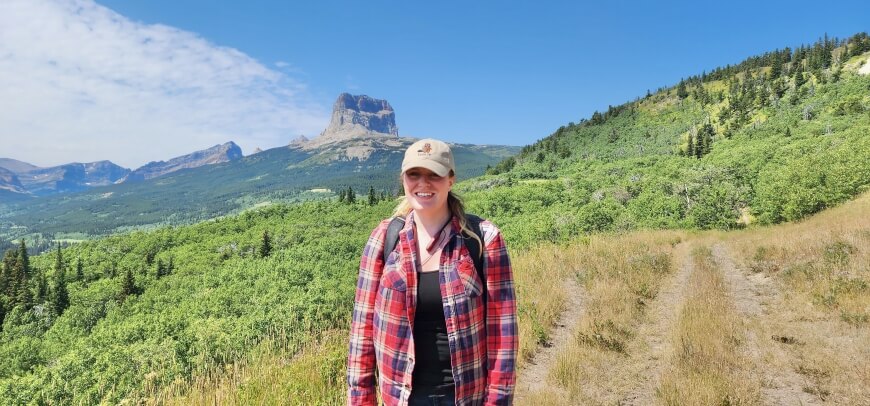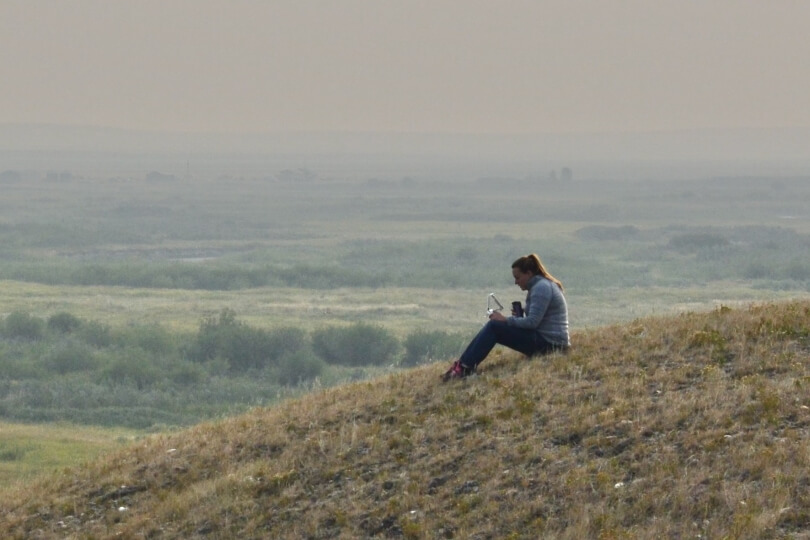Jordan Kennedy, S.M. '18, Ph.D. '23
Beavers are iconic engineers. Through the construction of dams, lodges, and excavation of ponds and canals, and the clearing of trails, beavers redesign entire landscapes. Over potentially thousands of meters, a damming complex can impound water, redirect flow, and transform dry valleys into wetland complexes. These structures are continually modified, repaired, and expanded across seasons and generations, influencing hydrology and sediment transport, altering plant communities, and creating habitat for countless other species.
Jordan Kennedy, S.M. ‘18, Ph.D. ‘23, knows a lot about beavers and their constructs. She’s been studying them since her Ph.D. thesis in materials science and mechanical engineering at the Harvard John A. Paulson School of Engineering and Applied Sciences (SEAS). Since graduating, she’s continued to explore how partnering with beavers can help restore North American landscapes. Through her current work at the Beaver Institute, Jordan also seeks to partner directly with tribal nations to restore landscapes and rebuild partnerships with non-human kin, not only to restore ecosystems but also to reconnect with tradition and land.
Currently, Kennedy is a Postdoctoral Research Fellow in the lab of Karen Lee Bar-Sinai at Harvard Graduate School of Design. Building upon her thesis findings, she is co-developing robotic landscaping tools informed by the behaviors of beavers.
“I find it difficult to believe we'll be able to engineer something better than a beaver can,” Kennedy said. “What we're interested in doing is studying how beavers build in terms of logic and dynamics. We view the design of beavers as a conversation between the landscape and the builder. What emerges at the interface of this conversation is a design that's bespoke to the landscape it's on.”
Jordan Kennedy, S.M. '18, Ph.D. '23, pilots her drone along a beaver dam as part of her SEAS Ph.D. research.
Kennedy didn’t initially arrive at SEAS as a Ph.D. student. After majoring in mechanical engineering at Montana State University, she took a job as an Applied Physics Fellow in the lab of David Weitz, Mallinckrodt Professor of Physics and Applied Physics at SEAS. A positive experience there convinced her to apply to the Ph.D. program.
“I did a lot of research during my undergrad, including being a first author on publications, and I loved, loved, loved doing research,” she said. “I was thrilled to have a job after graduating from undergrad. And then when I was there, I was so into the research and so interested in all the things that were going on.”
Beavers have always been part of Kennedy’s life. Growing up on a large cattle farm on the Blackfeet Reservation in Montana, she spent much of her childhood on the prairie and riverways near her home.
“My cousins and I would use beaver dams like water slides, because the water would get high and we'd slide over the dams,” she said. “I think it was so much a part of my life, I didn't really recognize it as being separate until I maybe moved away as an adult. When I'm living in an urban environment, my experience of being outside all the time and kind of embracing that is just not a common thing here.”
As a member of the Blackfeet tribe, Kennedy has always wanted to preserve tribal and Indigenous knowledge, even as she augmented it through years in academia. She was part of both the Harvard University Native American Program and the Harvard University Provost Advisory Council on Indigenous Affairs. After finishing her Ph.D., she worked as Science Director at INDIGENOUS LED. Since February, she has worked as the Tribal Partnerships Liaison and Beaver Behaviorist at the Beaver Institute, promoting the incorporation of tribal knowledge and Indigenous representation in the dissemination of knowledge about best practices concerning beavers in North American waterways. Recently, Kennedy was named as co-PI on a National Science Foundation Research Coordination Network Grant focused on knowledge sharing about the North American beaver. In September, she represented the Beaver Institute and her current research at the GSD at the International Beaver Conference in Inverness, Scotland.
“As an engineer, one of the frameworks that I use as a guiding principle about Indigenous thought is that we are a part of the ecosystem, and we are not separate from it,” she said. “As human beings, we are in constant relationship with our landscapes and the animals that we share them with. All the questions I ask, everything I'm interested in, always comes back to these fundamental first life experiences that I had growing up on a reservation within a tribal community. My upbringing has informed my curiosity, and my curiosity is helping me understand and deepen what I know about my culture.”
Kennedy is now about six months into her Postdoctoral position at the Harvard Graduate School of Design. In December, she will transition to the Woods Hole Oceanographic Institution to work with Nare Karapetyan, whose research focuses on building robots for marine exploration. In partnership with the Tlingit Tribe of southeast Alaska, she will begin research on clam gardens, a highly productive Indigenous aquaculture technology engineered and stewarded for millennia by many Tribes across the Pacific Northwest. Clam gardens not only provided a consistent and reliable food source, but also embodied cultural identity and resilience. Her research at Woods Hole continues to bridge Indigenous engineering traditions with contemporary ecological research to better understand how humans can engage sustainably with our environments.
“I think a lot about kin empathy, which is trying to imagine or think about how non-human animals behave,” she said. “The idea is how can we think like a beaver to design according to an existing landscape, instead of prescribing a form that might not be in alignment.”
Press Contact
Matt Goisman | mgoisman@g.harvard.edu

